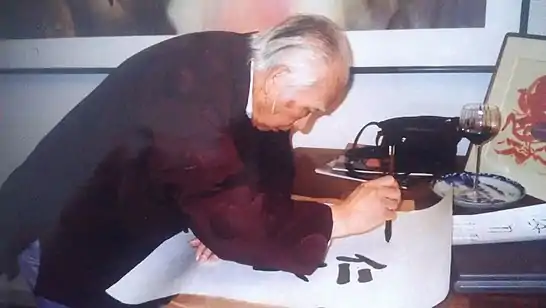Fred Fangyu Wang
Fred Fangyu Wang (Chinese: 王方宇; pinyin: Wáng Fāngyǔ; 1913 – October 6, 1997) was a Chinese calligrapher, art collector, and a Professor of the Chinese at Yale University and Seton Hall University.

Wang was born in Beijing in 1913, and emigrated to United States of America in 1945. Fred was an alumnus of the Catholic University in Beijing and Columbia University in New York City. In the 1940s he worked with Henry Courtenay Fenn on Chinese grammar at the Institute of Far Eastern Languages at Yale. He taught Chinese language and literature between 1945 and 1965 at Yale.[1] At Seton Hall University, he was the chairman of the department of Asian studies and curator of the Oriental Art Collection.[2] He was also part of the team which developed the first Chinese language teaching computer system. Several books and dictionaries on the Chinese language and calligraphy were written by him.
Wang was also an avid collector of Bada Shanren paintings and calligraphies. During his lifetime, he and his wife Sum Wai (沈慧) amassed the largest private collection of Bada Shanren's art. The Freer Gallery of Art later bought the entire collection from the couple's estate.[3]
When he died, he left behind relatives in mainland China, Taiwan, and the USA.[4]
References
- Dobrzynski, Judith H. (1997-10-11). "Fred Wang, 84, Artist and Scholar in Chinese (Published 1997)". The New York Times. ISSN 0362-4331. Retrieved 2021-01-26.
- Dobrzynski, Judith H. (1997-10-11). "Fred Wang, 84, Artist and Scholar in Chinese (Published 1997)". The New York Times. ISSN 0362-4331. Retrieved 2021-01-26.
- Cotter, Holland (2015-08-13). "Review: Bada Shanren, Chinese Art Superstar, Takes a Bow at the Freer (Published 2015)". The New York Times. ISSN 0362-4331. Retrieved 2021-01-26.
- Dobrzynski, Judith H. (October 11, 1997). "Fred Wang, 84, Artist and Scholar in Chinese". The New York Times. Retrieved 24 May 2014.
- Dobrzynski, Judith H. (October 11, 1997). "Fred Wang, 84, Artist and Scholar in Chinese". The New York Times. Retrieved 24 May 2014.
- Tabor, Brenda Kean; Kram, Barbara (2008). "In Pursuit of Heavenly Harmony: Paintings and Calligraphy by Bada Shanren (1626 - 1705) from the Bequest of Wang Fangyu and Sum Wai at the Freer Gallery of Art" (Press release). Freer and Sackler Galleries. Retrieved 2014-06-17.
Works
- Wang, Fred Fang-yü (1958). Chinese Cursive Script : An Introduction to Handwriting in Chinese. Far Eastern Publications Series. Yale University Press. ISBN 9780887100338. Retrieved 24 April 2014.
- Wang, Fred Fangyu (2002). Mandarin Chinese Dictionary: Chinese-English (unabridged, reprint ed.). Courier Dover Publications. ISBN 0486424774. Retrieved 24 April 2014.
- Wang, Fangyu (1983). Mandarin Chinese Dictionary: English-Chinese. Mei Ya Pub. Retrieved 24 April 2014.
- Wang, Fangyu (1972). Introduction to Literary Chinese, Volume 1. Seton Hall University Press. Retrieved 24 April 2014.
- Wang, Fred Fangyu (1972). Introduction to Literary Chinese, Volume 2. Seton Hall University Press. Retrieved 24 April 2014.
- Wang, Fangyu (1972). Text. Volume 1 of Introduction to Literary Chinese, Fangyu Wang. Seton Hall University Press. Retrieved 24 April 2014.
- Wang, Fred Fangyu. 文言入門. Eston Hall University Press. Retrieved 24 April 2014.
- Wang, Fred Fang-yu (1983). Huar shang de meiren. Far Eastern Publications. Retrieved 24 April 2014.
- Wang, Fred Fangyu (1985). Basic Skills in English/orange Level/grade 9. Mcdougal Littell Houghton. ISBN 9993117129. Retrieved 24 April 2014.
- Wang, Fangyu (1999). A Literati Life in the Twentieth Century: Wang Fangyu, Artist, Scholar, Connoisseur. Contributor China Institute in America. China Institute of America. Retrieved 24 April 2014.
- Ross, Claudia; Wang, Fangyu (2008). The Lady in the Painting: A Basic Chinese Reader. Illustrated by Luke Chen, Contributor Jocelyn Ross (illustrated ed.). Yale University Press. ISBN 030012516X. Retrieved 24 April 2014.
- Wang, Fred Fang Yu; Ross, Claudia (1966). Fenn, Henry C.; Lee, Pao-Chen (eds.). Character Text for Chinese Dialogues. Yale University Press. ISBN 0887100074. Retrieved 24 April 2014.
- Wang, Fred Fang-Yu; Ross, Claudia (1953). Lee, Pao-ch'en; Fenn, Henry C. (eds.). Chinese Dialogues: An Intermediate Level Text for Modern Chinese. Far Eastern Publications Series. Far Eastern Publications, Yale University. ISBN 0887100147. Retrieved 24 April 2014.
- Chang, Richard I. (2011). Wang, Fang-Yu (ed.). Read Chinese: A Beginning Text in the Chinese Character, Book 2. Contributor Henry C. Fenn. Literary Licensing, LLC. ISBN 1258081741. Retrieved 24 April 2014.
- Wang, Fred Fangyu; Fenn, H C; Tewskbury, M Gardiner (1961). Lee, Pao-Ch'En (ed.). Read Chinese. Jeffrey Norton Pub. ISBN 0884320901. Retrieved 24 April 2014.
